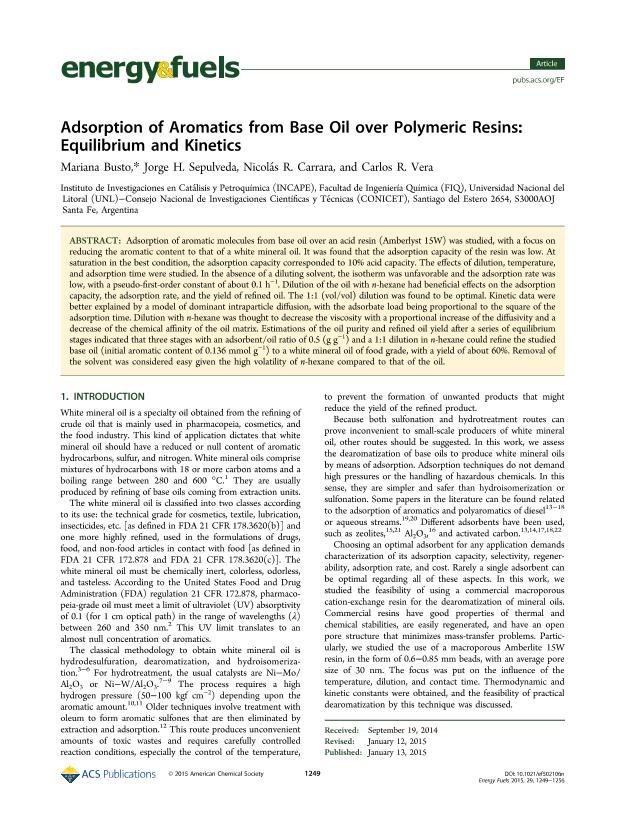Mostrar el registro sencillo del ítem
dc.contributor.author
Busto, Mariana

dc.contributor.author
Sepulveda Flores, Jorge Humberto

dc.contributor.author
Carrara, Nicolás Ricardo

dc.contributor.author
Vera, Carlos Roman

dc.date.available
2018-01-30T15:49:06Z
dc.date.issued
2015-01
dc.identifier.citation
Busto, Mariana; Sepulveda Flores, Jorge Humberto; Carrara, Nicolás Ricardo; Vera, Carlos Roman; Adsorption of Aromatics from Base Oil over Polymeric Resins. Equilibrium and kinetics.; American Chemical Society; Energy & Fuels (print); 29; 2; 1-2015; 1249-1256
dc.identifier.issn
0887-0624
dc.identifier.uri
http://hdl.handle.net/11336/34990
dc.description.abstract
Adsorption of aromatic molecules from base oil over an acid resin (Amberlyst 15w) was studied, with a focus on reducing the aromatic content to that of a white mineral oil. It was found that the adsorption capacity of the resin was low. At saturation in the best condition the adsorption capacity corresponded to 10% de acid capacity. The effects of dilution, temperature and adsorption time were studied.In the absence of a diluting solvent the isotherm was unfavorable and the adsorption rate was low with a pseudo first order constant of about 0.1 h-1. Dilution of the oil with n-hexane had beneficial effects on the adsorption capacity, the adsorption rate and the yield of refined oil. The 1:1 (vol:vol) dilution was found to be optimal. Kinetic data were better explained by a model of dominant intraparticle diffusion, the adsorbate load being proportional to the square of the adsorption time. Dilution with n-hexane was thought to decrease the viscosity with a proportional increase of the diffusivity, and a decrease of the chemical affinity of the oil matrix.Estimations of the oil purity and refined oil yield after a series of equilibrium stages indicated that 3 stages with an adsorbent-to-oil ratio of 0.5 (g g-1) and a 1:1 dilution in nhexane could refine the studied base oil (initial aromatics content 0.136 mmol g-1) to a white mineral oil of food grade, with a yield of about 60%. Removal of the solvent was considered easy given the high volatility of n-hexane as compared to the oil.
dc.format
application/pdf
dc.language.iso
spa
dc.publisher
American Chemical Society

dc.rights
info:eu-repo/semantics/openAccess
dc.rights.uri
https://creativecommons.org/licenses/by-nc-sa/2.5/ar/
dc.subject
Adsorption
dc.subject
Polymeric Resins
dc.subject
Aromatics
dc.subject
Kinetics
dc.subject.classification
Otras Ingeniería Química

dc.subject.classification
Ingeniería Química

dc.subject.classification
INGENIERÍAS Y TECNOLOGÍAS

dc.title
Adsorption of Aromatics from Base Oil over Polymeric Resins. Equilibrium and kinetics.
dc.type
info:eu-repo/semantics/article
dc.type
info:ar-repo/semantics/artículo
dc.type
info:eu-repo/semantics/publishedVersion
dc.date.updated
2018-01-18T14:39:35Z
dc.journal.volume
29
dc.journal.number
2
dc.journal.pagination
1249-1256
dc.journal.pais
Estados Unidos

dc.journal.ciudad
Washington
dc.description.fil
Fil: Busto, Mariana. Consejo Nacional de Investigaciones Científicas y Técnicas. Centro Científico Tecnológico Conicet - Santa Fe. Instituto de Investigaciones en Catálisis y Petroquímica ; Argentina
dc.description.fil
Fil: Sepulveda Flores, Jorge Humberto. Universidad Nacional del Litoral. Facultad de Ingeniería Química; Argentina
dc.description.fil
Fil: Carrara, Nicolás Ricardo. Consejo Nacional de Investigaciones Científicas y Técnicas. Centro Científico Tecnológico Conicet - Santa Fe. Instituto de Investigaciones en Catálisis y Petroquímica ; Argentina
dc.description.fil
Fil: Vera, Carlos Roman. Consejo Nacional de Investigaciones Científicas y Técnicas. Centro Científico Tecnológico Conicet - Santa Fe. Instituto de Investigaciones en Catálisis y Petroquímica ; Argentina
dc.journal.title
Energy & Fuels (print)

dc.relation.alternativeid
info:eu-repo/semantics/altIdentifier/url/http://pubs.acs.org/doi/pdfplus/10.1021/ef502106n
dc.relation.alternativeid
info:eu-repo/semantics/altIdentifier/doi/http://dx.doi.org/ 10.1021/ef502106n
Archivos asociados
